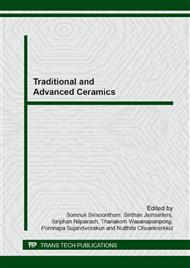p.3
p.8
p.14
p.21
p.26
p.31
p.37
p.41
Study of Residual Stresses in Traditional Ceramics
Abstract:
Residual stresses in traditional ceramics may have different origin and nature. In glazed tiles (both porous and sintered), they can be due to the thermal expansion mismatch of glaze and body. Another type of residual stresses in glazed and unglazed porcelain tiles is due to temperature gradients during cooling, which give rise to volume variations in different areas of the same ceramic ware. Thermal gradients may originate not only between the surface and the core of the tile, but also between the upper and the lower face of the tile. The common practice in the porcelain tile industry to use differential cooling to control the planarity of the finished product induces permanent changes of volume in different areas of the ceramic ware, which give rise to permanent states of stress. At room temperature there are two main stress relaxation mechanisms, depending on the nature of the tiles: cracks growth in porcelain tiles and post-expansion in porous tiles. Generally, residual stresses relaxation cause delayed curvature according to these different mechanisms. Optical dilatometry and optical fleximetry techniques allow to investigate the volume changes induced by the cooling rate and the glaze-body coupling, factors responsible for residual stresses.
Info:
Periodical:
Pages:
14-20
Citation:
Online since:
April 2014
Authors:
Price:
Сopyright:
© 2014 Trans Tech Publications Ltd. All Rights Reserved
Share:
Citation:


